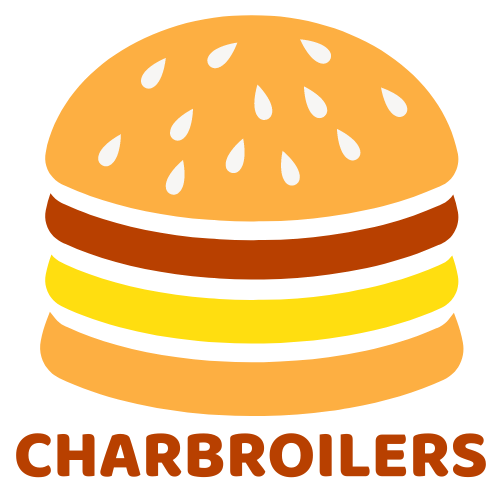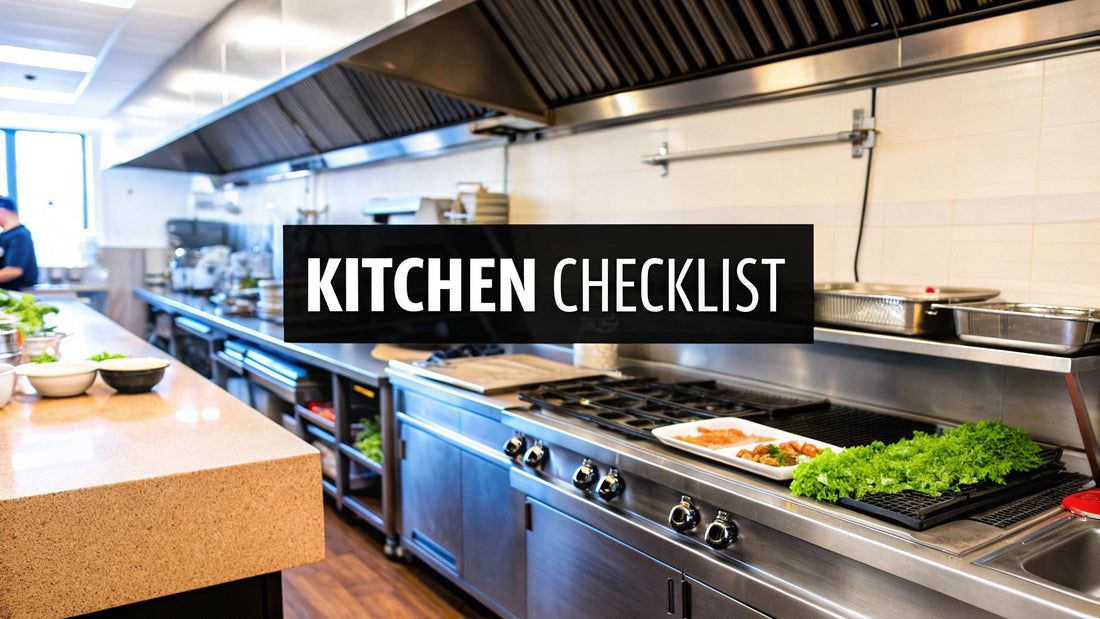
Your Commercial Kitchen Cleaning Checklist for Food Safety
Share
A solid commercial kitchen cleaning checklist isn't just another piece of paper taped to the wall—it's the backbone of a safe, efficient, and compliant kitchen. It turns the massive job of kitchen sanitation into a clear system, breaking down every task into daily, weekly, and monthly duties. We're talking everything from wiping down food-contact surfaces to deep-cleaning the guts of your equipment.
Why a Detailed Cleaning Checklist Is Your Kitchen's Lifeline
Let's get real. Just telling your crew "cleaning is important" is nowhere near enough. When you leave sanitation to chance, you're rolling the dice with foodborne illness outbreaks, crippling equipment failures, and health code violations that can shut you down.
A well-designed commercial kitchen cleaning checklist takes that overwhelming responsibility and makes it a manageable, repeatable process. It becomes your best defense against those risks, day in and day out.
This isn't just about passing the next health inspection; it's about building a culture of excellence. When your team has a clear roadmap for what needs to be done daily, weekly, and monthly, accountability skyrockets and your standards stay consistently high. Think of it like a commercial-grade maintenance checklist for the entire building—it’s a foundational system that keeps everything running smoothly and safely.
Building a Foundation for Success
The impact of a truly clean kitchen goes way beyond just looking good. It hits your bottom line, your brand's reputation, and even your team's morale. A pristine kitchen is a productive kitchen, plain and simple.
- Extend Equipment Lifespan: Daily cleaning stops grease and food crud from building up and wrecking your expensive machinery. This simple habit can save you thousands in repair calls and replacement costs for your ovens, fryers, and charbroilers.
- Boost Food Safety: A systematic cleaning schedule is your number one weapon against cross-contamination and bacterial growth. You're not just protecting customers; you're protecting your reputation.
- Improve Staff Morale: Nobody wants to work in a grimy, disorganized space. A clean kitchen is a safer, more pleasant place to be, which leads to happier, more efficient employees.
- Prevent Fire Hazards: Consistently degreasing vent hoods, filters, and cooklines isn't just about cleanliness—it drastically cuts down the risk of a devastating grease fire.
This flow chart breaks down the basic strategy for putting your cleaning plan into action.
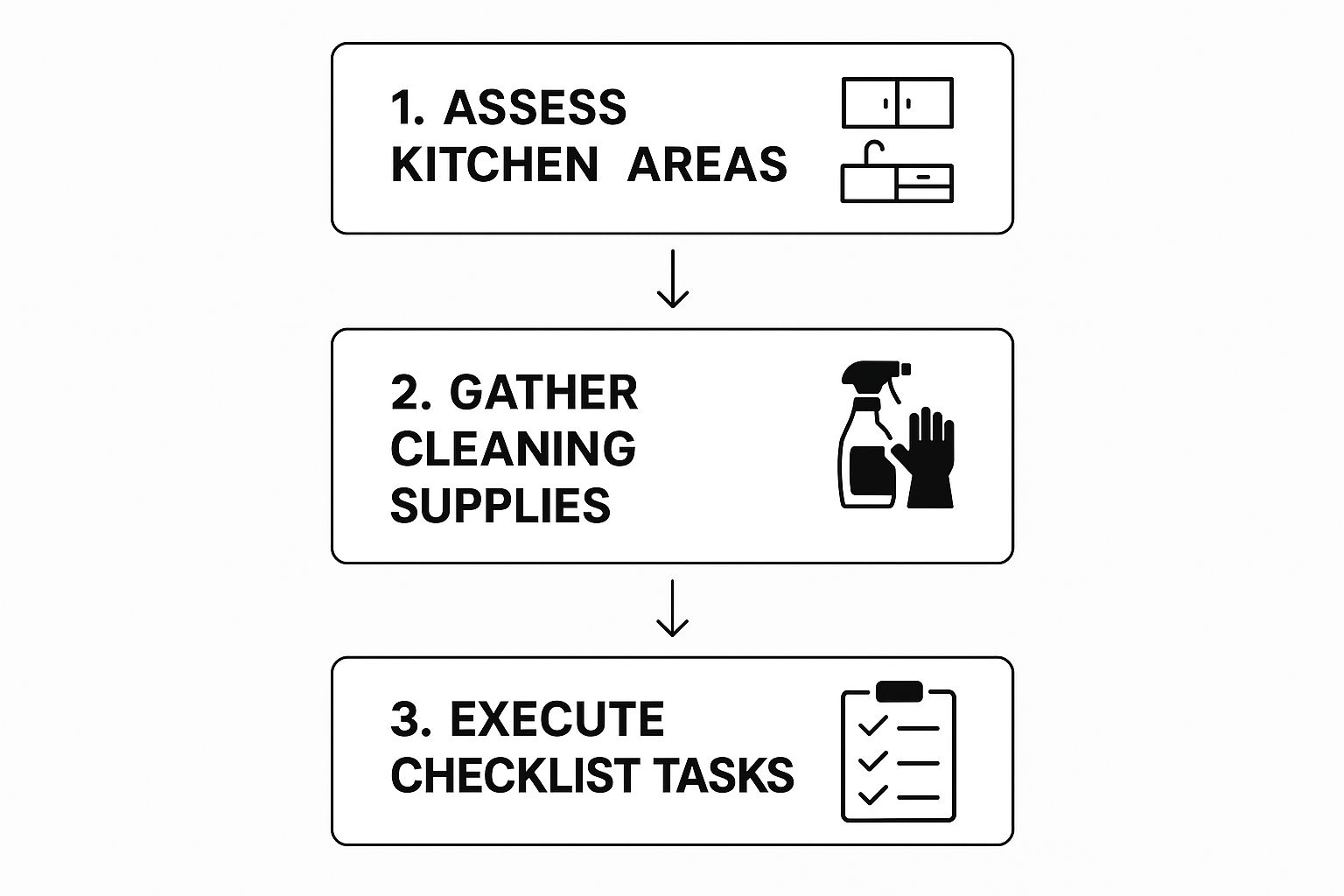
As you can see, a successful cleaning program starts with a clear assessment before a single spray bottle is picked up. It ensures you have a methodical game plan.
And the industry is paying attention. The global commercial kitchen cleaning services market was valued at around USD 385.7 million in 2024 and is expected to climb, driven by tougher health regulations. This guide will give you the framework to build a system that not only meets those standards but exceeds them.
Mastering the Daily Cleaning Routine
Consistency is the secret ingredient to a kitchen that’s always ready for a surprise inspection. Your daily cleaning routine isn’t just about wiping down counters at the end of a long shift; it’s a systematic shutdown that forms the absolute foundation of your food safety program. This is your first and most critical line of defense against cross-contamination and bacterial growth.
This daily grind is what stops minor spills and splatters from becoming major hygiene disasters. By embedding these tasks into your end-of-shift workflow, you guarantee that every single day starts fresh in a clean, safe, and efficient environment.
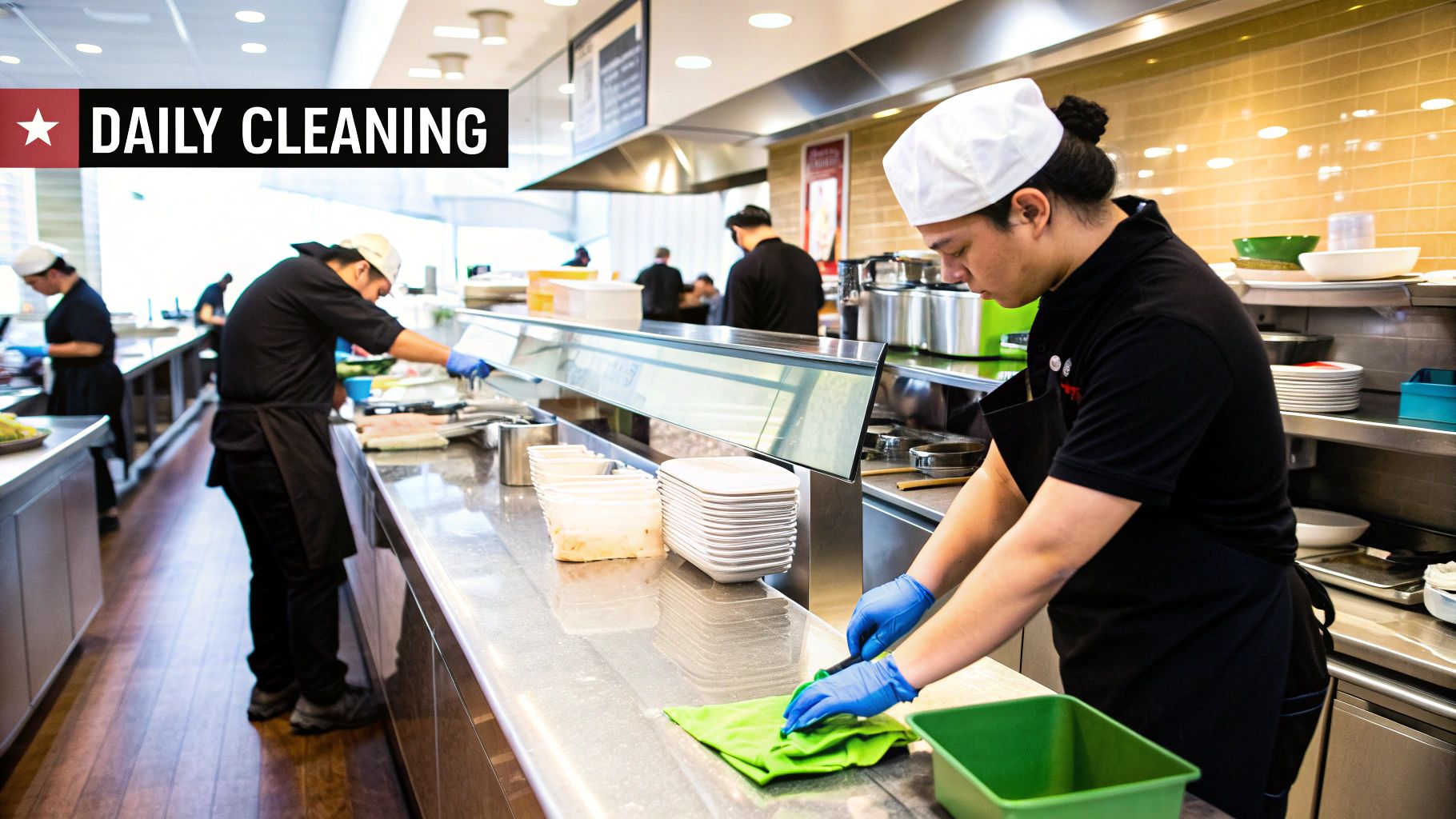
The Cook Line Shutdown
The cook line takes a beating during service, which is why its daily shutdown has to be a top priority. A buildup of grease and food particles isn't just gross—it's a serious fire hazard and a breeding ground for bacteria.
Here’s the non-negotiable breakdown:
- Griddles and Grills: Get all the food debris scraped off these surfaces while they're still warm. It makes the job ten times easier. Then, degrease the cooktop and, most importantly, empty every single grease trap. For specialized gear like flat tops, a precise cleaning protocol is crucial. We've got a detailed guide on the Atosa ATMG-36 that walks you through the specifics.
- Fryers: Wipe down the entire exterior of your deep fryers to get rid of any grease spatter. The floor and walls around the fryers need to be completely free of oil to prevent dangerous slips.
- Ranges and Ovens: Clean the stovetops and tackle any spills inside the ovens. Don't forget to wipe down all the knobs, handles, and doors—those are high-touch areas that get grimy fast.
Prep and Sanitization Stations
Think of these areas as cross-contamination hotspots. If they aren't handled correctly every single day, you're asking for trouble.
A rigorous, three-step process for cleaning food-contact surfaces is non-negotiable. This means all your prep tables, cutting boards, and slicers need to be washed, rinsed, and sanitized with a food-safe chemical solution after every single use.
Handwashing stations are another critical checkpoint. They have to be thoroughly cleaned and sanitized, with soap and paper towel dispensers refilled and ready for the next shift. It’s a simple step, but it’s absolutely vital for staff hygiene and stopping the spread of germs.
"Your daily cleaning isn't a chore; it's a commitment to your customers and your staff. The tasks you complete at the end of every shift directly impact the safety and quality of the food you serve tomorrow."
To help your team stay on track, a quick-reference chart can make all the difference.
Daily Cleaning Tasks at a Glance
This table breaks down the essential daily tasks, making it easy for your staff to see what needs to be done and why it's so important.
| Kitchen Area | Critical Daily Task | Reason |
|---|---|---|
| Cook Line | Scrape grills, empty grease traps, wipe down fryers. | Prevents grease fires and bacterial growth. |
| Prep Stations | Wash, rinse, and sanitize all food-contact surfaces. | Critical for preventing foodborne illness. |
| Handwashing Sinks | Clean, sanitize, and restock soap and towels. | Ensures proper staff hygiene and safety. |
| Dish Pit | Delime dish machine, clean filters, sanitize sinks. | Maintains equipment and ensures clean dishware. |
| Floors & Waste | Sweep/mop all floors and sanitize waste bins. | Reduces slip hazards and controls pests. |
Having a clear, visible guide like this helps build the muscle memory needed for a consistently clean kitchen.
Dish Pit and Floor Care
The final push in your daily routine focuses on warewashing and floors, ensuring the entire kitchen is completely reset for the next day.
Warewashing Area
- Clean and delime the inside and outside of the dish machine.
- Empty and scrub all the filter trays and screens. Clogged filters mean dirty dishes.
- Scrub and sanitize all three compartments of your sink system.
Floors and Waste Management
- Sweep every inch of the floor, especially underneath the equipment where debris loves to hide.
- Mop the floors with a good degreasing solution to prevent slips and nasty buildup.
- Empty every trash and recycling bin, taking the bags straight to the dumpster.
- Wipe down and sanitize the inside and outside of all waste bins before putting in new liners.
Nail Your Weekly Deep Clean for Unbeatable Kitchen Hygiene
Daily wipe-downs are great for handling the immediate mess, but the weekly deep clean is where you win the long-term war against grime. This is your chance to get ahead of the slow, sneaky buildup of grease and mineral deposits that a quick daily scrub just can't touch.
Think of it as a hard reset for your kitchen. Getting these tasks onto your commercial kitchen cleaning checklist is non-negotiable for keeping your equipment running smoothly, stopping stubborn contamination in its tracks, and making sure your kitchen stays compliant and efficient. If you let these things slide, you're inviting bigger headaches like equipment breakdowns, pest problems, or even a surprise visit from the health inspector.
Focus on Equipment and Water Sources
Some gear just needs more TLC than a simple daily wipe. If you ignore them, you're setting yourself up for a nasty accumulation of lime scale, baked-on carbon, and old grease. That stuff doesn't just look bad; it kills your equipment's performance and can even mess with the taste of your food.
Here’s what needs serious attention every week:
- Delime Your Sinks and Faucets: Hard water is a pain. It leaves behind that crusty, white lime scale that clogs faucets and leaves a gritty film in your sink basins. Grab a good commercial deliming solution and give everything a solid scrub to get rid of that mineral gunk. You'll get better water flow and a surface that's actually clean.
- Boil Out the Deep Fryers: Just draining the oil and wiping out the fryer doesn't cut it. You have to boil it out with a dedicated fryer cleaner. This is the only way to break down that stubborn, sticky, polymerized grease that’s glued to the heating elements and walls. Do this, and your oil will last longer and you won't get weird flavor carryover.
- Scrub Down Oven Interiors: Pull out the oven racks and let them soak in a powerful degreasing solution. While they're soaking, get inside the oven with a heavy-duty cleaner and go to town on all the carbonized food and grease that’s been baking on all week. A clean oven is an efficient oven—it heats more evenly and you won't have smoke and funky smells ruining your food.
Sanitize the Hidden Hotspots
Honestly, some of the most important weekly jobs are in places you don't even look at every day. These "out of sight, out of mind" zones can quickly turn into breeding grounds for bacteria and pests if you're not on top of them.
A weekly deep clean isn't just about appearances. It's about getting into the nooks and crannies where real trouble starts. This is what separates a kitchen that looks clean from one that is genuinely safe.
Make sure you hit these often-forgotten spots:
- Walk-In Coolers and Freezers: Get everything off the shelves. Sweep and mop the floors properly. Then, wipe down the walls and the shelving itself with a food-safe sanitizer. This gets rid of any hidden spills and stops mold or mildew from getting a foothold.
- Floor Mats and Drains: Haul every single floor mat outside. Scrub them down with a deck brush and a good degreaser and let them air dry. While they're out, pour an enzymatic drain cleaner or even just a bucket of hot, sanitized water down every floor drain. This keeps things flowing and kills off any nasty bacteria lurking in there.
- Wall Crevices and Shelving: That little corner where the wall meets the floor? It's a magnet for grime. Wipe it down thoroughly. Don't forget to dust and sanitize your dry storage shelves, too—it’s a good chance to look for any pest activity or small spills from leaky packages.
Your Monthly and Quarterly Maintenance Plan
If your daily and weekly tasks are about winning the immediate battles, your monthly and quarterly plan is how you win the war. This is where you zoom out and focus on the big systems—the ones that, if they fail, can lead to catastrophic breakdowns, fire hazards, or a visit from the health inspector that shuts you down.
Honestly, this is the stuff that separates the pros from the amateurs. A well-run kitchen has a proactive plan for these bigger jobs, while a poorly-run one is constantly putting out fires—both literally and figuratively. Think of this part of your commercial kitchen cleaning checklist as your long-term insurance policy.
Tackling Major Systems and Equipment
Some jobs are just too big for a weekly slot. They need more time, more muscle, and a deeper clean to knock out the serious buildup that can cause real trouble down the road.
Here’s what should be on your radar every month or quarter:
- Deep Clean Exhaust Hoods and Filters: Grease buildup in your ventilation system isn't just gross; it's one of the single biggest fire risks in any kitchen. Get those filters thoroughly degreased every month. Then, on a quarterly basis, the entire hood system—ducts, fans, and all—needs a professional cleaning. No excuses.
- Empty and Service Grease Traps: I’ve seen what a backed-up grease trap can do, and it’s a nightmare. We’re talking foul odors that clear a room and plumbing disasters that can close your doors for days. Depending on your volume, get this professionally serviced monthly or quarterly to stay compliant and avoid a costly, messy emergency.
- Calibrate Ovens and Thermometers: Off-temperature equipment is a food safety lawsuit waiting to happen. Every quarter, you need to calibrate every single oven, holding cabinet, and thermometer. It’s the only way to guarantee food is being cooked and held at safe temperatures, which is a non-negotiable part of any HACCP plan.
Beyond the weekly grind, your long-term plan should also bring in the specialists. Getting a professional commercial air duct cleaning is crucial for keeping your entire ventilation system clear of grease and working at peak efficiency.
Ensuring Regulatory and Safety Compliance
Let’s be clear: sticking to a long-term maintenance schedule isn’t just good business, it’s often the law. Food safety regulations are the main reason these checklists have become standard practice in kitchens all over the world.
A proactive maintenance plan is your best defense against a failed health inspection. It’s documented proof that you’re doing everything necessary to run a safe, hygienic kitchen. It protects your customers, your reputation, and your business.
Recent industry data shows that over 70% of food service businesses in developed countries now follow regular deep cleaning schedules to meet standards from agencies like the FDA and HACCP. It's just part of the game now. You can dive deeper into how compliance is shaping the industry by checking out these commercial kitchen cleaning insights from Zion Market Research.
This is also the perfect time to give your equipment a serious performance review. If you’re constantly fighting with a charbroiler that won’t hold its temperature or seems to need repairs every other week despite your best cleaning efforts, it might be time to stop throwing good money after bad. We carry a full lineup of commercial charbroilers built for the long haul, including high-efficiency infrared, workhorse gas, and precise electric char broilers. Sometimes, the smartest maintenance move is upgrading to reliable equipment that won’t let you down.
How to Properly Clean Your Commercial Charbroiler
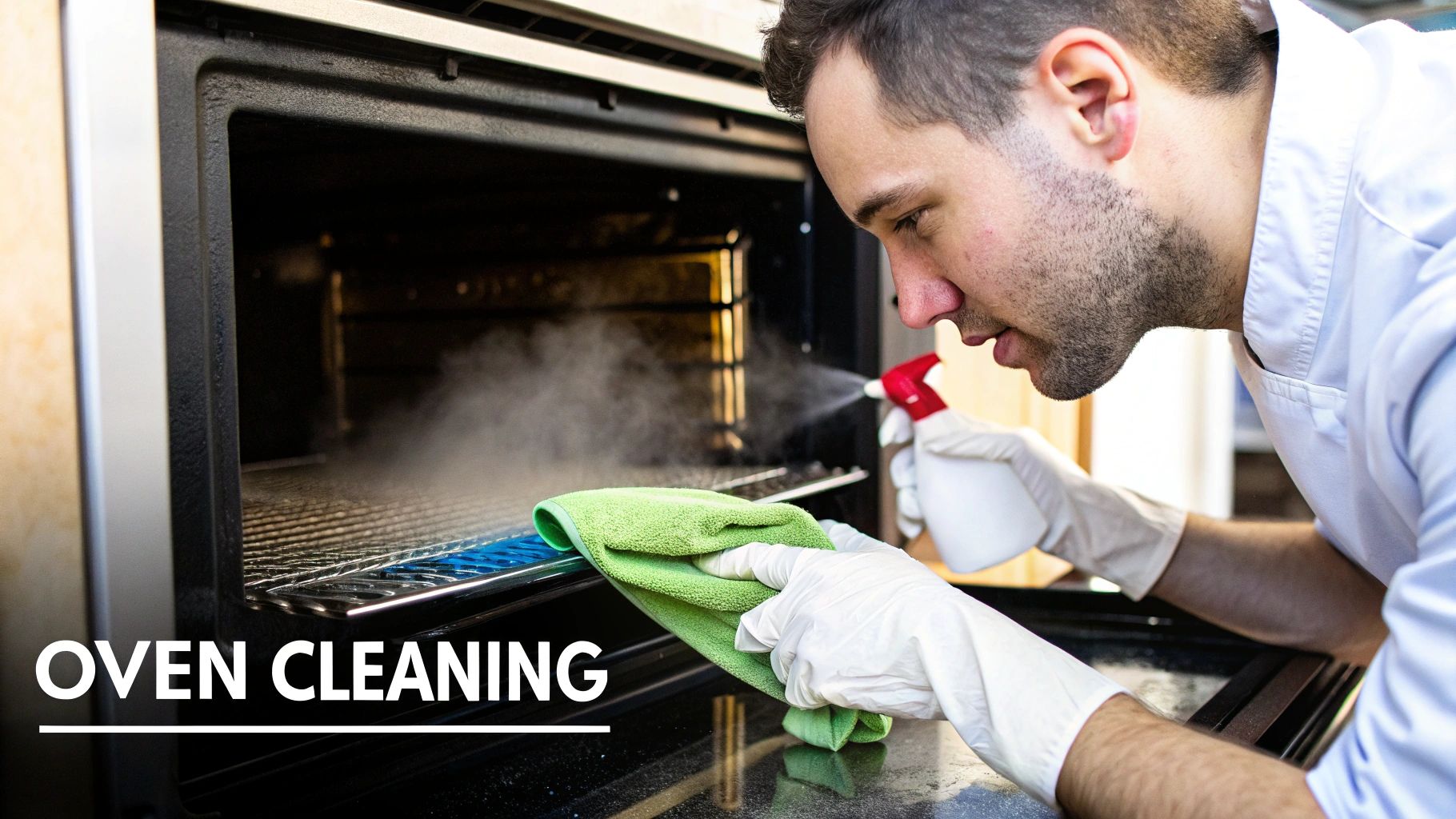
Let's be honest. A dirty charbroiler is a flavor killer. That black, carbonized gunk caked onto the grates doesn't just look bad—it transfers a bitter, burnt taste to your best steaks and vegetables. All those amazing natural flavors get completely steamrolled.
That’s why proper, consistent cleaning isn't just another box to tick on your kitchen checklist; it's non-negotiable. This goes way beyond a quick wipe-down. We're talking about a process that directly impacts your food quality, the lifespan of your equipment, and even kitchen safety by cutting down on dangerous flare-ups. A clean charbroiler is what delivers those perfect sear marks and the even heat that chefs live for.
Cleaning Techniques for Different Charbroiler Types
Not all charbroilers are built the same, so you can't clean them all the same way. Whether you're dealing with the intense blast of an infrared unit or the classic open flame of a gas model, you need to tailor your approach. The basic goals are the same, but the details really matter.
- Gas Charbroilers (Radiants or Lava Rocks): The best time to tackle this is right after service while the unit is still warm. Grab a heavy-duty grill brush and scrape all the food debris off the grates. Once the grates are off, get to the radiants or lava rocks below and brush away all that accumulated ash and carbon.
- Infrared Charbroilers: These things get incredibly hot, which conveniently incinerates a lot of the food residue for you. Give the grates a thorough scrape. The infrared emitters are mostly self-cleaning, but you still have to make sure no large chunks of food fall down and block the heat source.
- Electric Charbroilers: The process here is pretty similar to the gas models. Your focus is on the grates and the heating elements. The critical difference? Make absolutely sure the unit is completely cool and unplugged before you even think about starting. Clean the grates, then gently wipe down the electric elements to get rid of any grease spatter without damaging them.
No matter the method, the end game is always the same: get rid of that carbon buildup that makes food taste off. If you’re cleaning other similar gear, our post on the ultimate guide to cleaning a commercial stainless steel griddle has some great tips that will help.
Essential Charbroiler Cleaning Steps
Regardless of what model you have, a few daily steps are universal. If you skip these, you’re just asking for poor performance and expensive repair calls down the line.
- Scrape the Grates Thoroughly: This is the big one. Use a good wire brush or grill scraper and really get after it. You need to remove every bit of burnt-on food from the top, bottom, and sides of each grate.
- Clear the Burner Ports: If you have a gas model, clogged burner ports are your enemy. They create uneven flames and hot spots. A stiff wire or even a paperclip can be used to carefully clear out any blockages.
- Empty and Clean the Grease Tray: A full grease tray isn't just messy; it's a serious fire hazard. At the end of every single shift, that tray needs to be carefully removed, the grease properly disposed of, and the tray washed with hot, soapy water.
A clean charbroiler is a high-performance charbroiler. Consistent cleaning isn't just a maintenance chore; it's a fundamental step in producing high-quality, flavorful grilled food that keeps customers coming back.
If you find that your current unit just isn't cutting it anymore—even with diligent cleaning—it might be time for an upgrade. A modern charbroiler can bring a whole new level of temperature control and efficiency to your line. We offer a wide selection of commercial charbroilers for your restaurant, including powerful infrared, versatile gas, and precise electric char broilers designed to meet the demands of any professional kitchen.
Got Questions About Kitchen Cleaning? We've Got Answers.
Even with the best commercial kitchen cleaning checklist taped to the wall, questions are going to come up. It happens in every kitchen. Let's tackle some of the most common ones I hear from managers and new hires to make sure everyone's on the same page.
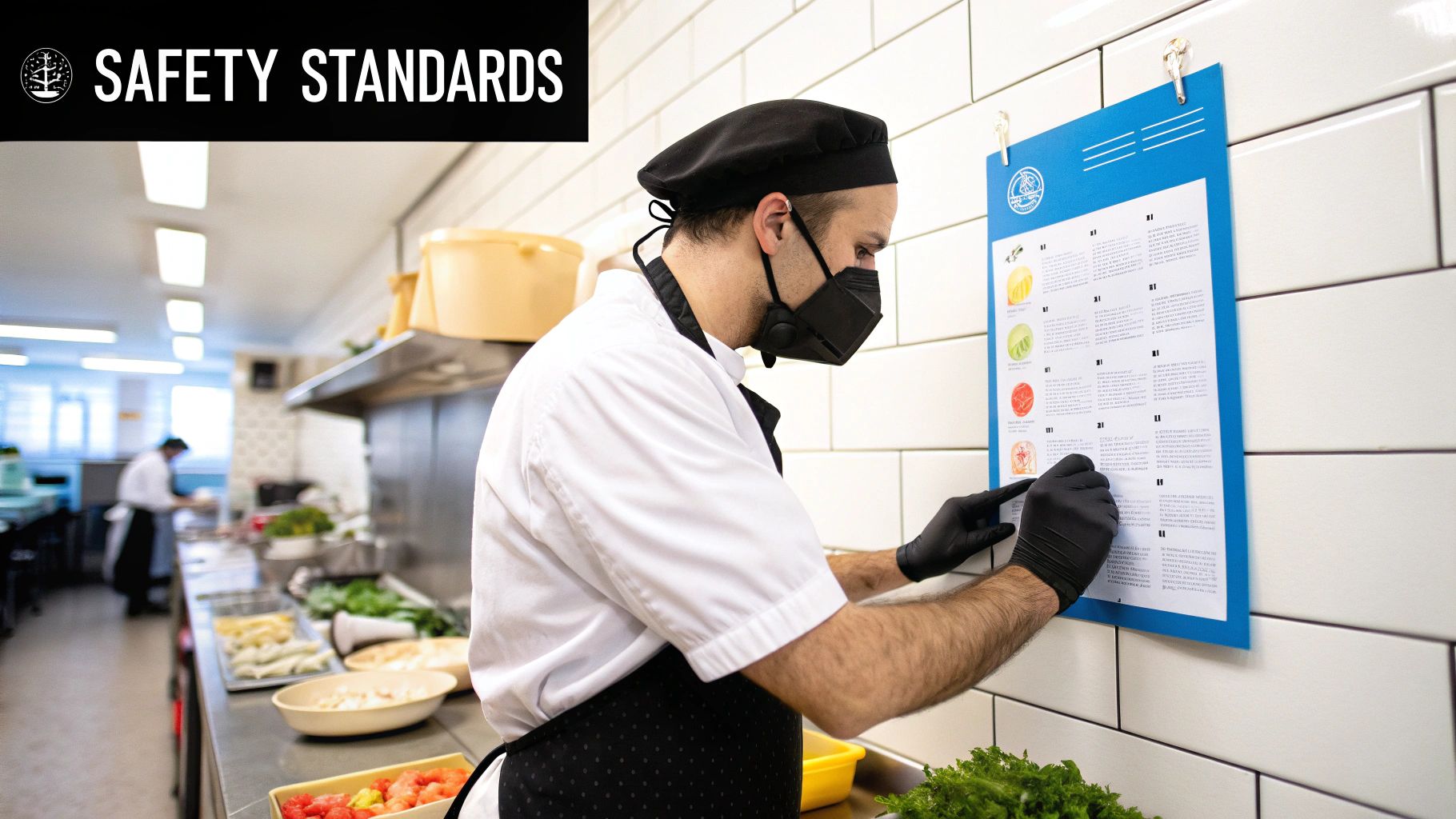
What's The Difference Between Sanitizing And Disinfecting?
This one trips people up all the time, but getting it right is non-negotiable for food safety. The distinction is actually pretty simple.
Sanitizing is what you do for any surface that touches food—prep tables, cutting boards, slicers. It knocks the number of bacteria down to a safe level, which is the industry standard. Disinfecting, on the other hand, is about killing nearly everything, viruses included. You'll disinfect surfaces like bathroom fixtures, door handles, or trash cans, but not a food prep counter.
For your day-to-day kitchen routine, you'll be sanitizing food-contact surfaces constantly.
Can I Just Use Household Cleaners In A Commercial Kitchen?
Absolutely not. Using household cleaning products in a professional kitchen is a shortcut that can lead to big problems. Commercial-grade cleaners are formulated specifically to cut through the heavy-duty grease and grime that a home kitchen never sees.
More importantly, professional chemicals are certified as food-safe for the surfaces where you prep ingredients.
Household products often aren't strong enough for the job and can leave behind chemical residues that are definitely not safe for consumption. Stick with the professional, food-grade stuff. It's the only way to guarantee you're meeting safety and compliance standards.
What Are The Most Common Cleaning Violations From Health Inspectors?
I've seen enough health inspection reports to know they tend to flag the same handful of issues over and over. If you know what they're looking for, you can stay one step ahead and keep your kitchen in the clear.
Here's what inspectors find most often:
- Improper sanitizing procedures, like using the wrong chemical concentration or not letting it sit long enough.
- Grease buildup is a huge one. They check behind the fryers, in the exhaust hoods, and on the walls.
- Handwashing stations that aren't properly stocked with soap and paper towels, or are blocked by equipment.
- Signs of pests, which is an immediate red flag that points to bigger gaps in your cleaning and sanitation routine.
Getting your daily cleaning down is step one, but it also pays to think like an inspector. Knowing what's on a good pest control inspection checklist helps you spot potential problems before they become violations. And for specific gear, understanding the details of your equipment, like knowing what a charbroiler is and its unique cleaning needs, is critical to avoiding those grease-related dings on your report.
Here at Charbroilers, we know that the foundation of a clean, safe, and efficient kitchen is high-quality equipment that's actually easy to maintain. If you're constantly fighting a losing battle with your current gear, it might be time for an upgrade. Explore our wide selection of commercial charbroilers—including infrared, gas, and electric models—all designed for top-tier performance and durability. Find the perfect fit for your restaurant at https://charbroilers.com.
